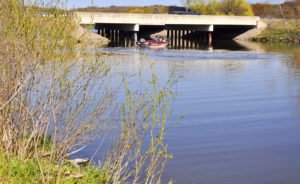by Dennis Dalman
news@thenewsleaders.com
Not all lake algae is bad, especially the golden algae discovered recently in Little Rock Lake – an indication that the lake-river drawdown last year is now showing promise.
The discovery was made in a sample of a phytoplankton colony taken from the lake at the public access just off of Hwy. 10 S. The samples taken were then analyzed at the St. Cloud State University Phytoplankton Laboratory, and that is when the “gold” was discovered.
The news was recently announced by the Minnesota Department of Natural Resources.
The golden algae, said a spokesperson for the DNR, is typical of a spring algae bloom in a healthy body of water. That kind of algae has not been found in Little Rock Lake for more than 10 years. Golden algae is one of three major algae groups in aquatic systems. The other two are known as green algae and cyanobacteria. For years, Little Rock Lake was dominated by cyanobacteria, the worst algae group for healthy lake ecology. That type of algae can produce toxins that pose a threat to public safety.
The golden algae are good news because they produce high-energy oils via photosynthesis that are good for fish. The green algae and some cyanobacteria will likely reappear as summer approaches, but the presence of the golden algae is an indication that the lake water’s healthy balance is being restored, said the DNR spokesperson. A cleaner, healthier lake will also have positive benefits for the Mississippi River at and north of Sartell to which the lake is connected.
Monitoring of the lake and river will continue through the summer.
The long-anticipated lake-river drawdown occurred during a six-week period from early August to mid-September of last year when the lake and river levels were lowered by 3 feet for that extended period. That was accomplished by opening the hydroelectric dam at Sartell. Then, many thousands of beneficial aquatic plants were planted by volunteers in areas of the lake exposed by the water draw-down. Those plants will thrive on the nutrients, such as nitrogen and phosphorous, in the water, helping keep the water cleaner and less susceptible to vast detrimental algae blooms.
The draw-down was a collaborative project by the Minnesota DNR, Benton County Soil and Water Conservation District, the Little Rock Lake Association and Eagle Creek Renewable Energy (which operates the dam at Sartell). Also involved were hundreds of volunteers that included lake residents and organizations such as the Boy Scouts.

Anglers head through the channel near the public access on Little Rock Lake.



